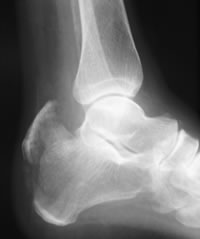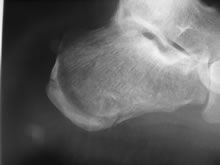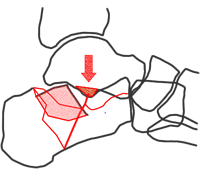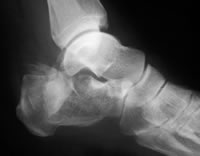


 |
 |
 |
Achilles tendon avulsion |
Tuberosity fracture |
Anterior process fracture |
Fractures of the body are divided into those which are extra-articular and those which are intra-articular, mainly into the subtalar joint.
Early classifications were based on plain radiography. The best known is that of Essex-Lopresti, who recognised peripheral and extra-articular injuries, and divided intra-articular injuries into:
This classification was related to his percutaneous reduction technique. As minimally invasive fixation has attracted more interest in the last few years, it is once again important to know the Essex-Lopresti classification.
 |
 |
 |
|---|---|---|
| The descending talus splits the calcaneum to produce a primary fracture line. A secondary fracture line emerges posteriorly. | A fragment including the entire upper surface of the calcaneum and part of the articular surface is formed | This is a tongue-type fracture |

|  |
 |
| The descending talus splits the calcaneum to produce a primary fracture line. A secondary fracture line emerges through the upper surface of the calcaneum | A fragment including part of the upper surface of the calcaneum and part of the articular surface is formed | This is a joint depression fracture |
Modern classifications are based on CT imaging of the posterior subtalar articular facet. Crosby and Fitzgibbons (1993) divided 30 intra-articular fractures into undisplaced, displaced but non-comminuted, and comminuted, and showed that severity corelated with outcome and response to surgery.
The main CT classification is that of Sanders. The main axis of classification is into
The type-2 and 3 fractures are subdivided on the position of the articular fracture lines, producing types 2A, 2B and 2C, and types 3AB, 3AC and 3BC.
 |
 |
 |
 |
The basis of the Sanders classification.The groups are denoted by the number of main fragments and the approximate main fracture lines as marked. |
A two-part fracture with the main fracture line through the mid-part of the joint - type 2B |
A three-part fracture with the main fracture lines lateral and central - type 3AB |
A four-part fracture with fracture lines lateral, medial and central - type 4ABC |
The main typings have been shown to influence prognosis and surgical complexity (Sanders ), and overall benefit from surgery (Buckley et al 2002). Furey (2003) studied interobserver variability using the Sanders classification and found moderate agreement with a weighted kappa value of 0.48 for the main classes and 0.56 including the subclasses. De Souza et al (2004) found 37/150 calcaneal fractures that could not be classified according to Sanders and described additional types and appropriate surgical strategies.